|
|
|
Sort Order |
|
|
|
Items / Page
|
|
|
|
|
|
|
| Srl | Item |
| 1 |
ID:
188817
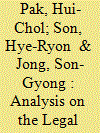

|
|
|
|
|
| Summary/Abstract |
The 1969 Vienna Convention on the Law of Treaties is a fundamental treaty providing rights and obligations that states assume in the conclusion and implementation of treaties. Some of the provisions of the Convention, however, continue to divide the legal scholarship. One of them concerns the legal definition of jus cogens provided in Article 53 of the Vienna Convention on the Law of Treaties. The international community, particularly the International Law Commission, has exerted strenuous efforts for a long time to reach a consensus on jus cogens. Nevertheless, the legal definition of jus cogens is still open to varying interpretation among different countries and international publicists.
In this light, the article analyses the legal definition of jus cogens in three aspects. First, the connotation of the concept ‘peremptory norms of general international law’ is assessed in terms of particular, general and universal international law. Second, it analyses some problems arising in understanding the non-derogability from and modifiability of jus cogens. Finally, the article discusses some issues regarding ‘acceptance and recognition’ of jus cogens by the ‘international community of states as a whole’.
|
|
|
|
|
|
|
|
|
|
|
|
|
|
|
|
| 2 |
ID:
131516
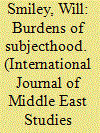

|
|
|
|
|
| Publication |
2014.
|
| Summary/Abstract |
This article analyzes the changing treaty law and practice governing the Ottoman state's attitude toward the subjects of its most important neighbor and most inveterate rival: the Russian Empire. The two empires were linked by both migration and unfreedom; alongside Russian slaves forcibly brought to the sultans' domains, many others came as fugitives from serfdom and conscription. But beginning in the late 18th century, the Ottoman Empire reinforced Russian serfdom and conscription by agreeing to return fugitives, even as the same treaties undermined Ottoman forced labor by mandating the return of Russian slaves. Drawing extensively on Ottoman archival sources, this article argues that the resulting interimperial regulations on unfreedom and movement hardened the empires' human and geographic boundaries, so that for many Russian subjects, foreign subjecthood under treaty law was not a privilege, but a liability.
|
|
|
|
|
|
|
|
|
|
|
|
|
|
|
|
| 3 |
ID:
131617
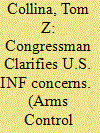

|
|
|
|
|
| Publication |
2014.
|
| Summary/Abstract |
A U.S. congressman provided new details in late April about the Obama administration's allegation that Russia may be breaching a key U.S.-Russian arms control treaty, stating that Moscow may have tested a cruise missile from a prohibited launcher. At a joint April 29 hearing of two House Foreign Affairs Committee panels, Rep. Brad Sherman (D-Calif.) said that Russia claims to have tested an intermediate-range missile for use at sea, which is allowed under the 1987 Intermediate-Range Nuclear Forces (INF) Treaty, but that Moscow used "what appears to be an operational, usable ground-based launcher," which is not allowed. Sherman said that "it appears as if [the Russians] were developing a ground-based capacity for this intermediate missile.
|
|
|
|
|
|
|
|
|
|
|
|
|
|
|
|
| 4 |
ID:
124724
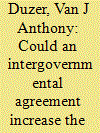

|
|
|
|
|
| Publication |
2013.
|
| Summary/Abstract |
Canada's federal government has exclusive authority to commit Canada to international treaties, but, under the Canadian constitution, compliance with treaty obligations that extend into areas of provincial competence is solely within provincial jurisdiction. As well, while Canada is responsible to its treaty partners if provinces act contrary to Canada's obligations, the provinces are not directly accountable. The absence of a direct legal requirement to fulfil treaty obligations means that incentives for provincial compliance are weakened and, in turn, that the reliability of Canadian obligations relating to matters within provincial jurisdiction is diminished.
This paper explores the prospects for using an intergovernmental agreement to address the gap between provincial action and federal responsibility. While such an agreement could express each province's commitment to comply with Canadian treaty obligations, intergovernmental agreements have some inherent weaknesses that make them an imperfect commitment device
|
|
|
|
|
|
|
|
|
|
|
|
|
|
|
|
| 5 |
ID:
089860
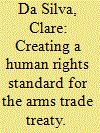

|
|
|
|
|
| Publication |
2009.
|
| Summary/Abstract |
This papaer will focus on the relationship between international human rights law and state authorization of conventional arms transfers and describe a workable human rights standard for arms transfer that could be included in an ATT.
|
|
|
|
|
|
|
|
|
|
|
|
|
|
|
|
| 6 |
ID:
134210


|
|
|
|
|
| Publication |
2014.
|
| Summary/Abstract |
This paper highlights several pivotal negotiating procedural steps that ultimately helped to promote the emergence of the final shape of the UNCLOS dispute settlement system. These steps include, for want of better phrasing, the following: (1) the package deal decision; (2) the consensus approach; (3) building consensus by privileging the best second choice; (4) building consensus by privileging the existing negotiating text through the rule of silence; and (5) failing consensus in the Negotiating Group, the Chairman presenting his own proposals as suggestions to the plenary. Needless to say, these steps are worthy of consideration by future treaty-makers and leaders in treaty-making when they are faced with complicated negotiating tasks, even if not as difficult as those during the monumental UNCLOS III.
|
|
|
|
|
|
|
|
|
|
|
|
|
|
|
|
| 7 |
ID:
132306
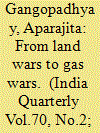

|
|
|
|
|
| Publication |
2014.
|
| Summary/Abstract |
Chile and Bolivia have been intertwined in a complex relationship of hostility and cooperation for over a century. Since the Bolivian defeat in the War of the Pacific and the Treaty of Peace and Friendship of 1904, issues of resource sharing and Bolivia's sovereign access to sea on the Pacific side have altered the dynamics of such a relationship. Indeed, they appear to be the major stumbling blocs to attempts at normalisation of relations between the two Andean neighbours. In the recent years, Chile-Bolivia relations have been strained over the issue of gas. Bolivia's political volatility over gas and Chile's refusal to discuss the issue of access to the sea were viewed as being part of the same quagmire of relations. However, despite disparities in development between the two countries, globalisation has altered the context of mutual engagement. Against this backdrop, the article specifically looks at one such contemporary issue of bilateral contestation, that is, the gas issue. The article will examine its geo-economic significance in the larger context of regional cooperation and energy security. It intends to probe the plausibility of the argument that the gas issue has the promise and potential to lighten the sedimented antagonism between the two.
|
|
|
|
|
|
|
|
|
|
|
|
|
|
|
|
| 8 |
ID:
146313
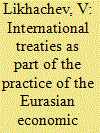

|
|
|
|
|
| Summary/Abstract |
THE EURASIAN ECONOMIC UNION (EAEU) is a new structure, and one with a strategic role in international relations. Its founding treaty of May 29, 2014 defines it as "an international organization for regional integration possessing international legal personality." The principal tasks of the EAEU, whose members are five sovereign and equal states - Armenia, Belarus, Kazakhstan, Kyrgyzstan, and Russia, - are to create conditions for the stable economic development of the member countries in order to raise the living standards of their population; to build common markets for goods, services, capital, and labor; and to ensure efficient cooperation between the member countries' economies, comprehensively modernize them and make them more competitive globally
|
|
|
|
|
|
|
|
|
|
|
|
|
|
|
|
| 9 |
ID:
131448
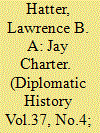

|
|
|
|
|
| Publication |
2013.
|
| Summary/Abstract |
This article reinterprets the Jay treaty by taking seriously the Republican criticism of the treaty's western provisions, which created a porous border between the United States and British-Canada. It argues that Laurentine merchants-entrepreneurs interested in the trade of the extended St. Lawrence River valley-used the Jay treaty as a charter, protecting their commercial and political rights as British subjects residing and trading in the United States. By exploring the conflicts between Laurentine merchants and federal officials over the terms of the Jay charter, this article opens a window on the complex process of state formation in the Anglo-American borderland between 1796 and 1819. It argues that state formation involved a wide array of activities and innovations at both the center and the periphery. More specifically, the article points to the important role that diplomacy, Republican commercial policy, and legal definitions of citizenship played in the creation of an American national state.
|
|
|
|
|
|
|
|
|
|
|
|
|
|
|
|
| 10 |
ID:
131615
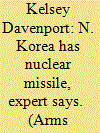

|
|
|
|
|
| Publication |
2014.
|
| Summary/Abstract |
North Korea probably can make nuclear warheads that are small enough to fit on its ballistic missiles, and activities at its nuclear test site and satellite launch facility likely indicate that Pyongyang is planning further tests to continue improving its nuclear arsenal, a former South Korean official said last month.
In a May 19 interview, the former official said that Pyongyang can "likely fit a nuclear warhead on a Rodong missile" although it is not certain that the warhead would detonate properly.
The medium-range Rodong missile, also known as the Nodong, is a deployed system with a range of 1,300 kilometers. This places South Korea, Japan, and parts of China within its range.
Experts have expressed skepticism in the past about North Korea's ability to deliver a nuclear warhead via a missile, but that sentiment apparently is beginning to shift.
|
|
|
|
|
|
|
|
|
|
|
|
|
|
|
|
| 11 |
ID:
129105
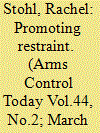

|
|
|
|
|
| Publication |
2014.
|
| Summary/Abstract |
On January 15, 2014, the United States released a document describing its new policy governing transfers of conventional weapons. The policy revision was long overdue, as the new publicly released document, Presidential Policy Directive 27 (PPD-27),[1] replaced a classified directive that came out in 1995.[2] The world has changed dramatically since the end of the Cold War. Until the release of the new policy document, however, the United States had been using policy guidance rooted in the geopolitical challenges created by the fall of the Soviet Union in making its arms transfer decisions and in outlining policy priorities and approaches to the global arms trade. According to a White House summary, a multi-year interval review of U.S. arms export policy "concluded that the 1995 conventional arms transfer policy was effective but needed to be updated to address 21st century national security and foreign policy objectives."[3] Thus, the new U.S. policy more accurately reflects the reality of U.S. arms transfers today. The Obama administration began its review when it came into office, but U.S. officials have said the impetus to finish the review came from events during the Arab Spring, when canisters of tear gas emblazoned with "Made in the USA" dominated pictures of the uprisings in Cairo's Tahrir Square. Questions surrounding U.S. arms sales to Egypt and other Arab countries led to increased scrutiny over the process of determining whether to transfer conventional arms and whether arms sales in fact led to U.S. influence over the recipient.
|
|
|
|
|
|
|
|
|
|
|
|
|
|
|
|
| 12 |
ID:
185642
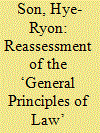

|
|
|
|
|
| Summary/Abstract |
Currently, there exist several academic and legal questions on which common perception is not established among states. One of them concerns the interpretation of ‘general principles of law’ mentioned in Article 38(1)(c) of the Statute of the International Court of Justice. Variance in the interpretation of ‘general principles of law’ manifests itself mainly in controversies over whether they are principles of domestic law or international law and over the implication of ‘civilized nations’ that qualifies ‘general principles of law’. The article aims at analysing such divergent views surrounding ‘general principles of law’ and voicing the authors’ view on the matter. By examining the principles in comparison with international conventions and custom, and in terms of wordings employed in the relevant provisions, the article attempts to demonstrate that they must be viewed as principles shared by national law systems of certain states. It also argues that in view of the essential characteristics of international law, and in terms of the meaning of the term ‘civilized nations’, ‘general principles of law’ cannot be deemed a universal source of international law, and in particular, that since the phrase ‘civilized nations’ was not intended to include all states in the world, it is necessary to amend the relevant wording.
|
|
|
|
|
|
|
|
|
|
|
|
|
|
|
|
| 13 |
ID:
132011
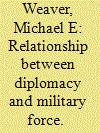

|
|
|
|
|
| Publication |
2014.
|
| Summary/Abstract |
Diplomacy and military force mutually support each other as instruments of national policy, functioning better in concert rather than as separate entities. The Cuban Missile Crisis is a useful case study of policymakers utilizing force and diplomacy synergistically. State Department efforts prior to the crisis paved the way for a unified front with Latin American neighbors against the emplacement of Soviet missiles in Cuba. With a backdrop of nuclear threats supporting the more usable capabilities of conventional air strikes, invasion forces, and blockading ships, the American threat of force made a negotiated settlement attractive to the leadership of the Soviet Union. The risks and political damage commensurate with the use of force encouraged the Kennedy administration to pursue a diplomatic solution. Military leaders tended to not consider the political effects of the use of force. President Kennedy understood the interrelationships between force and diplomacy, as did State Department leaders.
|
|
|
|
|
|
|
|
|
|
|
|
|
|
|
|
| 14 |
ID:
131618


|
|
|
|
|
| Publication |
2014.
|
| Summary/Abstract |
Meeting for the final time before their review conference next spring, parties to the nuclear Nonproliferation Treaty (NPT) gathered for two weeks at the United Nations, but were unable to adopt a common set of recommendations. This outcome could serve as a preview for the 2015 review conference, where disagreements are expected about the pace of nuclear disarmament efforts.
Enrique Román-Morey of Peru, who chaired the April 28-May 9 preparatory meeting, was unable to bridge differences and produce a consensus report on recommendations for the 2015 conference. At a May 9 press conference after the meeting ended, Román-Morey said agreement was not possible because there was not enough time to resolve key issues, such as the pace of disarmament by the nuclear-weapon states and the establishment of a Middle Eastern zone free of weapons of mass destruction.
|
|
|
|
|
|
|
|
|
|
|
|
|
|
|
|
| 15 |
ID:
131897
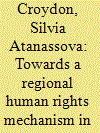

|
|
|
|
|
| Publication |
2014.
|
| Summary/Abstract |
Stretching a third of the way around the globe, the Asia Pacific is the world's most populous region. Yet, it remains the sole region without a human rights court or commission, and without a human rights treaty. The notable absence there of a human rights mechanism based on such institutions is often explained away by reference to the region's size and heterogeneity, the constituent states' reluctance to interfere in the affairs of others, and the existence of rivalries. Whilst agreeing that there is no inter-governmental initiative that looks set to change the present state of affairs in the Asia Pacific, this article places the spotlight on another model of creating a regional human rights mechanism, that is, the unique and burgeoning Asia Pacific Forum of National Human Rights Institutions. Specifically, it assesses the prospects for Japan, Taiwan and China - three key regional players whose membership of the Forum is still outstanding - to create domestic human rights bodies that eventually join.
|
|
|
|
|
|
|
|
|
|
|
|
|
|
|
|
|
|
|
|
|